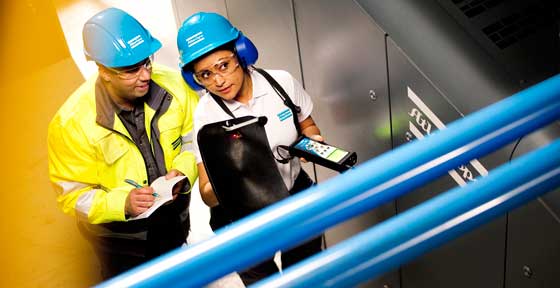The following is an excerpt from the article Five strategies for finding waste in compressed air systems, by Steve Bruno, product marketing manager, oil-injected screw compressor 30kW -90kW, Atlas Copco Compressors. Read the full version online or in the December issue of Plant Engineering.
The most expensive component in the total cost of compressed air—including capital costs and service and maintenance costs—is energy consumption. In fact, over the lifespan of a compressor, energy typically costs several times more than the purchase price of the compressor. Thus, maximizing the energy efficiency of the compressed air system is a vital strategy for total facility cost savings.
Yet, estimates indicate that poorly designed and maintained compressed air systems in the United States account for up to $3.2 billion in wasted utility payments every year. General neglect of compressed air equipment is leaving a lot of money on the table, and facility managers should take note. What would you do with the tens of thousands of dollars you could be saving by simply optimizing your compressed air system? Expand operations? Add a new production line? Hire additional employees?
Finding waste in compressed air systems requires sharp eyes, sharp ears, and a sharp strategy. From simple tasks like walking the line to replacing outdated compressors with more energy-efficient equipment, the following strategies can help facilities save energy and reduce costs to boost the bottom line.
Strategy #1: Plug the leaks, save thousands on your energy bill
Why is it so important to address leaks in the compressed air system? Let’s consider the numbers. A single, 1/4-in. air leak can cost more than $10,000 annually. And a typical plant that has not been well maintained will likely have a leak rate equal to 20% to 30% of total compressed air-production capacity. In large manufacturing facilities, a few leaks could easily add up to $100,000 of wasted energy in just one year.
Clearly, even the smallest of compressed air system leaks can be a big drain on resources. Where there are leaks in the piping, there are also pressure drops, which force the compressed air system to work harder and use more energy. Eliminating pressure drops throughout the compressed air system has a domino effect that can result in significant and ongoing cost savings.
Luckily, there are several easy and relatively inexpensive things facilities can do to address leaks in the system. Walking the line is the simplest of all audit procedures and is comprised of a visual inspection of the various components of the compressor system including but not limited to the compressor room, filters, piping, and condensate drains. A basic audit is often available from compressor manufacturers at no charge and can reveal simple ways to maximize efficiency and boost productivity.
Keep Reading…
You can read the full article, which provides four more strategies for finding waste in compressed air systems, here: Five strategies for finding waste in compressed air systems. If you would like to learn more about Atlas Copco’s energy saving products and services, contact us or leave a comment below.
You may also enjoy the following articles:
- Centralized Vacuum for the Plastics Extrusion Industry
- How clean is your compressed air?
- Don’t Overlook Compressed Air in Food and Packaging Automation
Source: Compressed Air Blog


